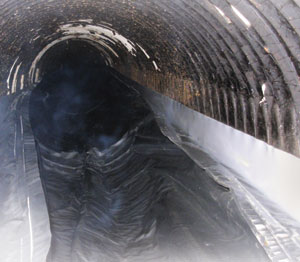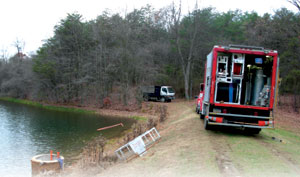CIPP Benefits Resort Dam
 Water levels at a popular Perry County, Pa., lake where visitors enjoy fishing, boating and swimming began dropping off to the point where those activities were being hindered. What resort owners needed was a way to rehabilitate an aging and structurally damaged pipe that was causing the problem, thus returning the water levels to normal without disturbance to the surrounding area.
Water levels at a popular Perry County, Pa., lake where visitors enjoy fishing, boating and swimming began dropping off to the point where those activities were being hindered. What resort owners needed was a way to rehabilitate an aging and structurally damaged pipe that was causing the problem, thus returning the water levels to normal without disturbance to the surrounding area.
Lake Heron is a 10-acre, spring-fed lake that is located in Liverpool, Pa., about 30 miles north of Harrisburg, Pa. The relaxing retreat is a 200-plus acre property owned by S. Dean Stephens that offers visitors a multitude of outdoor activities and features hiking trails, wildlife habitat areas, areas for swimming, fishing and boating, as well as primitive campsites. The project was scheduled in late November, as to not interfere with normal resort activities.
The culprit of the infiltration was about 112 ft of a 24-in. corrugated metal pipe, located under a dam and serving as the outfall pipe for Lake Heron’s overflow structure. The bottom of the 44-year-old outfall pipe had rusted out, resulting in substantial leaking.
Enter cured-in-place pipe (CIPP) lining as the method to rehab the structurally damaged pipe. This project marks somewhat of a unique application for CIPP, as the pipe in need of rehabilitation was neither a sewer pipe or storm sewer line, which are the typical recipients of CIPP. This project is an example that shows that the CIPP process can be used outside those parameters.
“The level of the lake was actually dropping to the point where enough water was leaking through the dam breast that it couldn’t maintain its level to allow people to boat, fish and swim,” explained Hap Witmer, general manager of Abel Recon, a rehab contractor in Mountville, Pa., that handled the project. “We had to line a pipe that was deteriorated with a good bit of infiltration-and-inflow (I/I) coming in, which was allowing the lake level to drop. The whole purpose of the project was to stop that I/I and allow the water level to return to its normal height.
“When we started out, the level was roughly 2 ft below normal,” Witmer said. “When we finished, it took about two weeks for it to return to its normal level.”
The Problem
“This was allowing any water that was getting into the outfall pipe to leak out faster, allowing the water level to drop,” Witmer said. “We had to seal up the overflow structure, as well as the outfall pipe.”
The first thing Abel Recon had to do was stop any infiltration coming out of the spillway. De neef’s Hydro Active cut chemical grout was applied to the spillway pipe to seal it; this grout is a hydrophobic polyurethane that is designed to fill large voids and for the cut-off of gushing water with high pressure and speed. Then, the crew began the lining process. As a certified installer for Reline America, Abel Recon used Blue-Tek CIPP technology to line the pipe. Blue-Tek uses ultra violet (UV) light to cure the liner in place.
Blue-Tek Technology
“One of the things that is unique about our product that made it a good choice for the Lake Heron application is that we manufacture our liner with the pre-liner,” said Tracy Mitchell, Reline America’s associate director of marketing and business development. “So if we are installing or having to rehab a pipe that had active water flowing or leaking, that doesn’t interfere with our product. In some cases, people are putting cured-in-place liner in a pipe with no pre-liner so if there is any type of water in the pipe, it mixes with the resins, which makes the resin not cure as well.”
All that was needed for the Lake Heron project, like all projects involving Blue-Tek technology, was a curing truck and service truck. Abel Recon set up its equipment by the overflow structure, Witmer said. “Our only access was from the [overflow structure] side,” he said. “We did cart the liner down to the bottom side with a forklift to make things go faster and pull it in. We pulled the liner in from the overflow structure and cured from there as well.”
Mitchell said the Lake Heron equipment setup was typical for its projects. “We have a curing truck that operates our ultra-violet equipment and the key piece is a ‘light train,’ which is pulled through the pipe and puts out the ultra-violet light that cures the liner in place. On the opposite end, we have a winch to pull the liner into place and a blower to inflate it.”
After the outfall pipe was lined and cured, Abel Recon used Sprayroq’s Spraywall on the inside of the overflow structure to strengthen it. Spraywall is a 100 percent VOC-free polyurethane coating that provides both structural enhancement and chemical resistance against all elements that eat away at underground structures.
Witmer said the project went by the book from beginning to end. The Pennsylvania Department of Environmental Protection (DEP) — which oversees the lake — even gave its permission without a fuss to use the Blue-Tek technology. “The DEP liked [the product’s] structural capability and the fact that it did not have any styrene release,” he said, noting that the DEP was more than pleased with the CIPP technology.
“Everything went smooth,” Witmer added. “The curing process took approximately 90 minutes and the whole installation, including cleaning the pipe and video inspecting it, was all done in the same day.”
Witmer also noted the technical support Reline America gave his crew during the project. “This was one of the biggest liners we’ve done to date,” he said. “And this is another avenue for us as a contractor to do future outfall rehabilitation and structures.”
Abel Recon became a Reline America certified applicator in September 2007 and to-date has done roughly 5,000 ft of CIPP work. The company’s background started in structural rehabilitation with Sprayroq and then it got involved in CCTV inspection, pipe cleaning, chemical root control and now lining.
Sharon M. Bueno is managing editor of Trenchless Technology.
